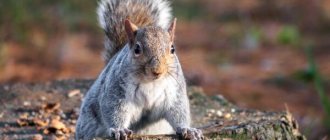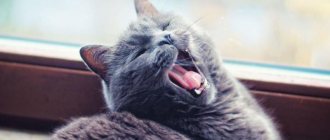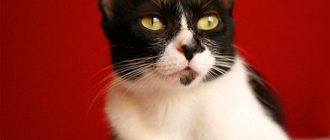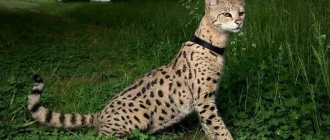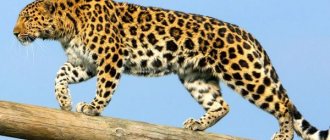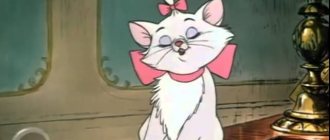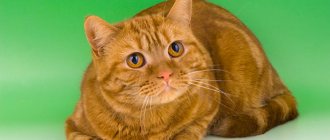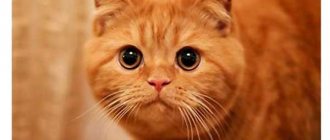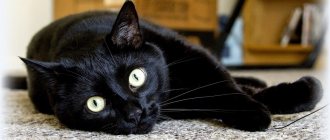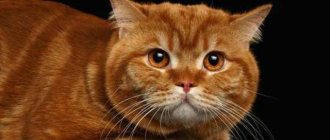People have long chosen the animals that captured their hearts - cats. Red cats are especially popular; many legends, tales and omens are told about them.
People have long chosen the animals that won their hearts - cats
The most famous sign is that a ginger cat brings happiness to the house. It is considered a particularly good sign to let a pet into a new apartment before its owners, then the pet will immediately enter the house and, with its presence, drive out everything bad from the home. They also say that red-haired fatties bring money. Not in a literal sense, of course, but the financial situation of their owners will rapidly improve.
Features of color and character
The fiery color is caused by the Orange gene, which is most common in males. Indeed, the ginger cat is much less common in nature. This is caused by genetic characteristics in animals.
The most famous sign is that a ginger cat brings happiness to the house
“Sunny” color has its own specifics - it cannot be solid; most often there are striped or marble shades. Dilution of this gene led to the appearance of another color, which can be called cream or “cafe au lait.”
Red panda: description
The “fire fox” first became known in the 13th century. In the Middle Kingdom this animal was called “hon ho”. As for Europe, thanks to the efforts of Frederick Cuvier, who managed to get ahead of the Englishman Thomas Hardwicke, despite the fact that the latter learned about the existence of this animal a little earlier.
It’s just that Cuvier was the first to return to the European continent and named this animal “Ailurus fulgens”, which means “brilliant cat”.
Appearance
The size of the panda is comparable to the size of a large cat, which gained weight of at least 6 kg and grew to 0.6 meters in length, while the length of the tail almost corresponds to the length of the body. The red panda has thick and long hair, which gives the impression that this animal is very well-fed, although in fact this is not the case at all. The body is elongated, and the head is wide with relatively small ears. The muzzle is funny, pointed, and the eyes are dark and shiny. Body structure does not depend on gender. The tail is thick and long, red in color, decorated with numerous light-colored rings that are located across the tail.
The animal’s legs, although short, are strong and end in paws on which hair grows. This helps the animal move without problems on ice and snow. The paws are armed with fairly curved semi-retractable claws. When the animal walks, its paws only half touch the base. The red panda has extra toes on its front paws, formed by hypertrophy of the radial sesamoid bone. The extra finger points in the opposite direction and helps the animal hold the bamboo branches.
Important point! Not all individuals are distinguished by a fiery (red) shade of fur, especially since there are 2 subspecies. The Stajana panda has a darker coat color, although colors can vary within each subspecies. Both red and yellow-brown individuals are often found.
The presence of rusty shades in the main color of the predator helps the animals to camouflage perfectly, especially against the background of red lichens that are present on the trunks and branches of fir, which grows in China.
Behavior and lifestyle
Red pandas prefer to lead an isolated lifestyle, but during breeding periods they form pairs. These are territorial predators who prefer to hunt in personal areas with an area of up to 10 square km, while females have a personal territory that is 2 or even 3 times smaller. The boundaries of the territory are marked with special secretions, urine and droppings. These markers contain a lot of information about the animal living within a specific area.
The animal goes hunting after sunset, and in the daytime the animals, choosing one of the poses, rest on branches or in their hollows. When the ambient temperature is completely comfortable, the animals lie flat (belly down) on tree branches, and their limbs hang down. After resting or eating, they begin to lick themselves, washing their faces and stretching, and also rubbing their bellies or backs on a tree trunk or rock.
Interesting moment! Moving through the treetops, the panda's long tail serves as a balancer. When the animal decides to go down to the ground, it moves along the tree trunk with its head down. At this moment, the tail serves as a kind of safety element for the animal, preventing the animal from falling.
The red panda also feels great on the ground, moving quickly through the snow with peculiar leaps. You can often see them playing with each other, standing on their hind legs and spreading their front legs, as if imitating an attack. Moreover, in fights they never allow each other to be injured.
RED PANDA: THE MIRACLE ANIMAL
How long do red pandas live?
Living in its natural environment, the average lifespan of a red panda is no more than 10 years, while in captivity, animals can live almost 2 times longer. One of the pandas that lived in the zoo lived for 18 and a half years.
These are unique animals because they are able to independently control their energy expenditure. This is especially important in harsh winters, when energy reserves are always running low. In this case, the panda curls up into a tight ball, which helps it retain the heat and energy of its body.
Natural habitats
The red panda's habitat is very limited, so the animals are found in such provinces of China as Sichuan and Yunnan, as well as in the territories of Myanmar, Nepal, Bhutan, including northeast India. No one has seen these animals west of Nepal. It is believed that the homeland of the red panda is the territory of the southeastern Himalayas, where they live at an altitude of up to 4 kilometers. It should be noted that the habitat of the ancestors of the modern panda was noticeably wider, since the remains of animals were found both in eastern Europe and in North America.
Interesting moment! Paleogeneticists believe that the habitat of modern pandas is associated with certain living conditions, with an ambient temperature of 10 to 25 degrees and an amount of precipitation per year of no more than 350 mm.
For its life activities, the panda chooses areas covered with tall mixed forests, which include both coniferous species with a predominance of fir and deciduous species with a predominance of oak, chestnut and maple. Deciduous trees reliably protect the lower tier, where bamboo and rhododendron grow. Green spaces are shrouded in clouds for a long period of time, which leads to the active growth of lichen and moss, which densely cover tree trunks and branches, as well as rocks. Due to the increased humidity, the plant density is quite high, so the roots are literally intertwined with each other. This allows you to hold the soil on slopes, regardless of their steepness. In addition, the process of moisture accumulation occurs.
What do red pandas eat?
The panda spends more than 12 hours a day searching for and eating food. As a rule, the animal finds food for itself on the ground. This predator is very strange, since the basis of its diet is made up of food components of plant origin such as:
- Bamboo shoots and leaves.
- Roots and fruits of various plants.
- Herbs and lichens.
- Berries and acorns.
- Gribov.
Only with the onset of autumn does the animal switch to eating animal food in order to make at least some reserves of nutrients. The red panda's digestive system is more designed to digest animal food than plant food, so plant components are difficult to digest.
Interesting to know! The panda's body absorbs only 25 percent of the nutritional components of bamboo. Therefore, the animal carefully grinds the rough components using its teeth equipped with special tubercles.
Due to digestive problems, animals prefer to eat young and tender, as well as juicy shoots. They eat 4 kg of greenery in the form of shoots and one and a half kilograms of leaves per day. Interestingly, pandas living in captivity refuse to eat animal food. The predator, as a rule, kills animals that are placed in its cage, but refuses to eat.
Reproduction and offspring
The mating season begins in January. It is during this period that contacts begin between males and females, who actively mark their territories, indicating that they are ready for sexual contact.
Females behave very actively and this is due to the fact that this period for them is quite fleeting and lasts a maximum of 24 hours.
The female carries her offspring for 115-140 days, although the development of the embryo is delayed by an average of a month. Before birth in May/June/July, the female begins to arrange her nest, finding a place for this between rock crevices or in an abandoned hollow. A panda usually gives birth to one cub, although up to 4 babies can be born, but this happens very rarely.
Once born, panda cubs weigh no more than 135 grams, and their body is covered with fawn-colored fur. After birth, the female begins to lick the young, placing scent marks on them so that they can be identified when returning to the nest. She doesn’t go out anywhere for about a week, being close to her offspring. After a week, the female leaves the nest, and can go quite far, returning only to feed her cubs.
Interesting to know! After three weeks, the puppies begin to see, but they do not leave their nest until they are 3 months old. After this time, at one point, the cubs begin to foray out of the nest at night. After 5 months, the female stops feeding them with her milk.
The offspring are distinguished by their high attachment to their mother, while they do not know their father, and they will never know, since the male, having impregnated the female, leaves her alone with his future offspring and does not take any part in their upbringing. The young leave the mother's nest as she begins to prepare for the next mating process. During this period, she becomes nervous and aggressive. Young pandas grow quickly, so by the time they are one year old their size is comparable to that of adults. After another six months, the individuals are ready to reproduce.
Natural enemies
While in the wild, pandas are hunted by snow leopards and red wolves, and the likelihood of such an attack decreases every year, since the number of these dangerous predators for pandas decreases significantly from year to year. Fleeing from their natural enemies, animals quickly climb high into a tree with the help of sharp claws. If a panda is on the ground at the time of a predator’s attack, it stands on its hind legs, bending its body, and also emitting an unpleasant-smelling liquid. Some eyewitnesses claim that in this state the panda makes a heartbreaking cry, although in a calm state it is difficult to get any sounds from them.
Gallery: red cats (25 photos)
Breeds with a “sunny” color
Red fatties can be representatives of many cat breeds. True, this color is not defining for any of them and is considered a rarity. Most of these cats are among ordinary outbred animals.
The most common breeds of red cats are the varieties of pets known to everyone from childhood.
These include breeds:
- British;
- Scottish;
- Siberian;
- Persian;
- Maine Coon.
British and Scottish kittens of this color are rare, but not out of the ordinary. British redheads have a Red color, which implies a rich, uniform shade without the addition of white hair. There can be a tortoiseshell color, as well as tabby (striped), which is a combination of different shades of color.
Population and species status
The red panda was endangered, so it was listed in the International Red Book and assigned the appropriate status. Over the past 2 decades alone, the total number of these animals has decreased by 2 times. Unfortunately, experts say that the population decline will not stop there, but, on the contrary, will increase.
Interesting data! Today, according to experts, there are no more than 20 thousand red pandas left in the world. At the same time, about 7 thousand live in China, about 6 thousand in India, and only a few hundred such animals in Nepal. The reduction in the total number is mainly due to human economic activity, which is actively cutting down forests that are habitual habitats for pandas.
In addition, the panda is exterminated by indigenous peoples because of the bright red color of their coat. Moreover, they learned to eat panda meat, which is distinguished by the presence of a characteristic musky taste. Other parts of the red panda's body are also used purely for medicinal purposes.
Considerable damage to the population is caused by poachers who catch animals and sell them for keeping at home, but they do not take into account the fact that the animals do not feel well in such conditions and die. The Chinese use panda fur to make clothes and hats. In Yunnan province, a panda fur hat is considered one of the best decorations for the bride and groom, indicating their happy future in marriage. In the small state of Sikkim, which is located in northeast India, this animal is considered a national treasure, and in Darjeeling, the red panda is considered a symbol of the International Tea Festival.
Red pandas thrive in zoos and reproduce without problems. In this regard, animals are always in demand in zoos. Typically, pandas are supplied to various international zoos from Nepal. As far as is known, about 300 individuals are currently kept in 85 zoos around the world, and the same number have been born.
